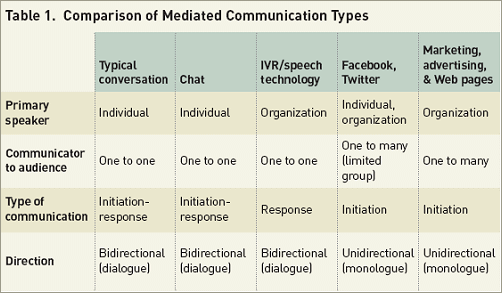All Dressed Up with Nowhere to Go
During the past few months, I’ve belatedly ventured into the new world of online social interaction. I baby-stepped my way in, mainly as a social-psychological experiment with a participant sample of one. First, I posted a profile on my employer’s intracompany Beehive (IBM’s internal Facebook). It turned out that usability test recruitment via Beehive was a little misguided on my part, so I went back to the drawing board. Then I entered a profile on Facebook, originally intended to make me part of IBM’s student mentoring program, but it quickly became a pipeline to many long-lost friends. It was totally not what I expected. I quietly stuck a big toe in Twitter, but it felt a little too Lord of the Rings for me—this part isn’t going so well.
During the course of my experiment, I came across an article about social media that questioned whether it would sound a death knell for the interactive voice response (IVR) systems that people so love to hate. Maybe it was wishful thinking on the writer’s part. On the other hand, it does seem fairly clear that, in the grand scheme of things, IVR and speech are the ugly stepsisters to just about every other form of technology.
Are we all dressed up with nowhere to go? Before we hang up our ball gowns, maybe our invitation to the dance is temporarily lost in the mail. Let’s carefully step into our dancing shoes and embrace these related technologies for what they can teach us about human interaction and our craft, as well as the questions they raise for mediated human communication as a whole.
 Consider the comparisons in Table 1. Of course, there are exceptions, but the four comparative categories help illuminate a couple of central points. First, organizations have significant experience communicating to a broad audience (one to many) and are used to selecting the topic themselves with relatively little opportunity for response. This paradigm is business-as-usual communications for most organizations. Facebook and Twitter now provide a similar ability to individuals, elevating message relevancy (or lack thereof) to a now widely discussed issue. Second, in the continuum of interaction types, IVR and speech technologies stand out because they put organizations in an unfamiliar, responsive role. Few have nimbly adapted to the expectations of this role. Accordingly, excessive initiation of topics deemed irrelevant by users is a major reason so many automated systems are frustrating and minimally usable. Finally, mediating technologies increase the accountability of not being adept with social interaction. You’d be amazed how many people Twitter when they’re on the line with an IVR, for example.
Consider the comparisons in Table 1. Of course, there are exceptions, but the four comparative categories help illuminate a couple of central points. First, organizations have significant experience communicating to a broad audience (one to many) and are used to selecting the topic themselves with relatively little opportunity for response. This paradigm is business-as-usual communications for most organizations. Facebook and Twitter now provide a similar ability to individuals, elevating message relevancy (or lack thereof) to a now widely discussed issue. Second, in the continuum of interaction types, IVR and speech technologies stand out because they put organizations in an unfamiliar, responsive role. Few have nimbly adapted to the expectations of this role. Accordingly, excessive initiation of topics deemed irrelevant by users is a major reason so many automated systems are frustrating and minimally usable. Finally, mediating technologies increase the accountability of not being adept with social interaction. You’d be amazed how many people Twitter when they’re on the line with an IVR, for example.
So back to the original question: Will social media kill speech and IVR technology? Not likely. Customers will always need to initiate communication, and businesses will need to respond. But newer technologies are certainly changing the context in which IVR should be understood and the purposes for which it is used. Organizational outcomes are optimized when both the technical and social aspects of communication are carefully controlled through design, which is made possible by top-down strategizing and execution that incorporates all of the technologies equally. When an organization hyperfocuses on some channels to the exclusion of others, unpredictability ensues across the entire communication system.
In our current world, IVR could well be considered the weakest link in the communicative chain, precipitating the Twitter backlash so forcefully articulated in 140 characters today.
We designers can be patient. Our chance to dance in the spotlight is coming as our skills become better understood, our profession becomes more clearly defined, and we demonstrate real business outcomes through successful projects. In the meantime, don’t let those fancy shoes collect dust. Learn about, get involved with, and even try your hand at designing other forms of communication technology. It never hurts to have a dazzling foxtrot ready when you’re finally asked to dance.
Melanie Polkosky, Ph.D., is a social-cognitive psychologist and speech language pathologist who has researched and designed speech, graphic, and multimedia user experiences for more than 12 years. She is currently a human factors psychologist and senior consultant at IBM. She can be reached at polkosky@comcast.net.